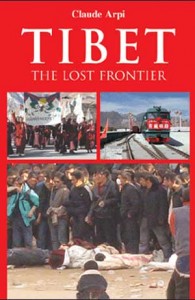The fate of Tibet was sealed and the consequences followed one after another, the first being the signature in Beijing in May 1951 of the “˜Agreement on Peaceful Liberation of Tibet.
“… In view of dangers of present situation and drift to war, any attempt which prevents war and safeguards interests of China should be welcomed by Chinese Government. … We suggest to you to clarify our position to the Chinese Government both in regard to Tibet and wider issues in as friendly a manner as possible.”
Tibet had been sacrificed for “wider issues”.
Efforts to revive the case in the UN continued for a few more weeks. On December 18, Bajpai told Henderson that the Government of India was still interested in Tibet’s case before the UN but “had delayed action pending outcome its efforts assist in achieving cease-fire in Korea.”
Bajpai assured the American Ambassador that the Indian Government “would probably re-examine whole problem of Tibet just as soon as it had done all it could in matter of cease-fire.”
However on December 30, Henderson cabled Acheson to inform him that:
“Representatives GOI had repeatedly assured us it intended do so [support Tibetan appeal]. Now appears views B.N. Rau and other Indian officials who do not wish India make any move in present world context which might offend Communist China have prevailed.”40
“Is it logical for UN which gave Indonesia which was under Dutch sovereignty hearing to ignore Tibet? Will India, for instance, have greater respect for UN if merely out of deference to it, UN gives Tibet no opportunity to present her case?”
Fifty eight years later, the case is still ‘pending’!
Notes
- Collection Jean Lassale, Paris (France).
- The co-leader of the Tibetan delegation.
- Fifty years later, it is still hard to grasp the difference.
- The Buddha, the Dharma and the Sangha.
- When, a couple of months later, some members of the delegation left Yatung for Beijing, they were again told to keep in daily wireless contact with the Dalai Lama’s government in Chumbi valley.
- See page 138.
- He cited the case of the Dogra War when the Sikhs of Zorawar Singh were decimated during the winter in Tibet.
- SWJN, Series II, Vol. 15 (2), p. 335. Tibetans Free to Appeal to the United Nations.
- Sir Benagal N. Rau, the Indian Representative to the UN.
- SWJN, Series II, Vol. 15 (2), p. 339.
- For the text of the Appeal see The Dalai Lama, My Land and my People (New York: Potala, 1983), p. 249.
- November 7, 1950 of the roman calendar.
- Shakabpa, the Chief Negotiator, had cabled the appeal from Kalimpong.
- Mainly due to the poor transmission network in Tibet.
- Including India, UK and US.
- The Yangtse in Tibetan.
- The Hindu, Madras, 13 November 1950.
- The Hindu, Madras, 14 November 1950.
- The Hindu, Madras, 16 November 1950.
- Nobody was ready to issue visas on Tibetan passports at this point in time.
- It has to be noted that when Tibet sent delegations to the UN in 1959, 1961 and 1965, resolutions were passed in favour of Tibet, but it involved strong lobbying by the Tibetan delegates.
- SWJN, Series II, Vol. 15 (2), p. 347. Cable from Nehru to Rau dated 19 November 1950.
- Rau stated that no member of the Security Council appeared to be inclined to sponsor the Tibetan appeal mainly on grounds of the ‘doubtful’ status of Tibet and a general lack of knowledge about the problem, and asked for instructions in case the matter was brought up.
- USFR, Telegram, 793B.00/11-2050 dated November 20,1950. The Ambassador in India to the Secretary of State.
- USFR, Telegram, 793B.00/11-2050 dated November 20,1950.The Ambassador in India to the Secretary of State.
- Emphasis by the author.
- SWJN, Series II, Vol. 15 (2) p. 345. Policy Regarding Tibet, note dated 18 November 1950.
- Panikkar, the Indian Ambassador in China, and some other Indian officials were pushing harder than anyone else.
- Sister of Jahawarlal Nehru and Indian Ambassador to the UN.
- The Hindu, Madras, November 21, 1950.
- Lake Success is the Headquarters of the UN in New York.
- Sen, Chanakya, Tibet Disappears (Bombay: Asia Publishing House, 1960), p. 93.
- SWJN, Series II, Vol. 15 (2), p. 347. Cable from Nehru to B.N. Rau dated 20 November 1950.
- The same thing would happen in 1959, 1961 and 1965 when the Tibetan issue was again brought up in the UN.
- Quoted in Goldstein, op. cit., p. 718. Telegram from the UK delegation in New York to London dated 14 November 1950, (FO/371/84454).
- SWJN, Series II, Vol. 15 (2), p. 347. Cable from Nehru to Rau dated 19 November 1950.
- SWJN, Series II, Vol. 15 (2), p. 351. Cable from Nehru to B.N. Rau dated 23 November 1950.
- It is interesting to note that a scholar has recently made a study of the Tibetan issue in the UN and has found out that the matter is still pending and could theoretically be taken up again from where it was left in November 1950.
- The Hindu, Madras 1 November 1950.
- USFR, Telegram 793B.00/12-3050 dated December 30, 1950. The Ambassador in India (Henderson) to the Secretary of State.





